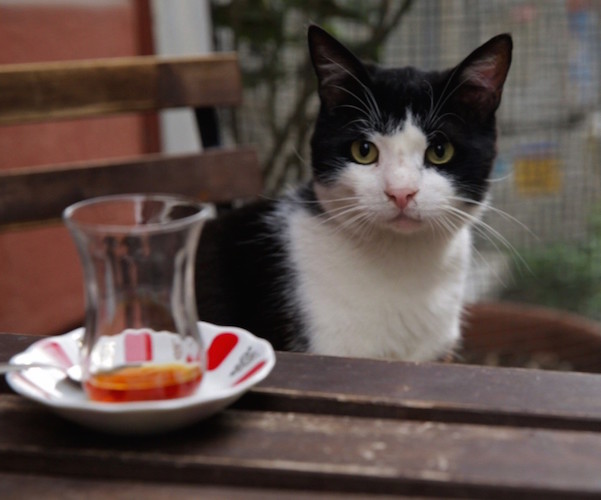Film Review: “Kedi” — Caring for a City of Cats
This endearing but unsentimental film explores the myriad connections that many Istanbul residents have to their feline neighbors.
Kedi, directed by Ceyda Torun. (In Turkish with English subtitles). At the Kendall Square Cinema, Cambridge, MA

A cat waits for food and friends at an Istanbul cafe in “Kedi.”
By Peg Aloi
Director Ceyda Torun’s first feature length documentary, Kedi is a delightful, engaging look at the city of Istanbul’s population of street cats. These cats live mostly out of doors and have no official owners but, as the film demonstrates, these animals are fed, cared for, and often loved by the people in their neighborhoods, for whom they are a constant and reassuring presence. Some of the cats have names, some have routines, some are constant visitors, and some are only seen intermittently. But every single one of them has a personality, and these idiosyncrasies are a frequent topic of conversation in the interviews with these human caretakers.
This endearing but unsentimental film explores the connections that many Istanbul residents have to their feline neighbors. There is a sense of responsibility that Istanbul business owners feel towards these animals, even though they never claim to own them. Some of the cats hang around fish markets or butcher shops, hoping for scraps, and the workers and owners make sure the cats are fed, possibly to keep them coming around and providing a valuable service: rodent control. But these symbiotic relationships are not just about cats’ usefulness; there is genuine affection and amusement portrayed again and again, and the human subjects seem to take great joy in describing “their” cats’ favorite treats, unusual talents or daily activities. The appearance of the cats in the mornings for food at homes and cafes stands as an integral part of the workday.
A middle-aged fisherman who has suffered a fair amount of loss in his life reveals that rescuing cats keeps him going. They provide companionship on his fishing boat, and are rewarded with friendship and all the fresh fish scraps they can eat. An elderly woman spends her entire day feeding dozens of cats that come to her for sustenance, and seems to know each one individually, despite the fact that, being a close-knit colony, many of the cats resemble each other physically. She buys and prepares freshly-cooked chicken for them; she confesses that caring for them aids her own healing journey. One elderly shopkeeper smiles as he strokes “his” cat, saying he knows what gives her pleasure, and teasing her about her reaction when he stops petting her. One somewhat standoffish tomcat has a very detailed and quirky routine for obtaining his daily meal and never wavers from it. He rarely comes close enough for a pat; his dutiful food-bearers can’t help but wonder why he’s afraid. But they accept him as he is, and greet him warmly when he comes looking for breakfast.
Some American cities have enormous feral cat populations, partly due to cats being left behind by renters who move to new housing that does not allow cats. Some animals learn to fend for themselves, eating garbage or possibly hunting wildlife; but it’s a rough and tumble existence for an animal that is used to warm bedding and bowls of kibble. Volunteer groups (such as Boston’s Second Chance Shelter for Cats) will arrange to trap, spay, or neuter them and make sure that they have up to date vaccinations. They release them again because their feral nature may often make them unadoptable as house pets. Such animals live in the shadows, grateful for food and shelter, but often wary of offers of affection. In Kedi, there are some cats who are warier than others, and the city residents accommodate them as best they can, making sure there is food and water available, and trying to help when a hungry litter arrives, or a cat seems injured or sick. But, by and large, the concept of a “feral” existence is not the norm here: rather, there are simply a great many cats in this beautiful, ancient city, and the people acknowledge and care for them, and that seems to be the way it has always been.
The reasons behind the pervasive feline presence in Istanbul are not explored. Neither does the film’s portrait of daily life in Istanbul document its political turmoil. Unless one includes the rise of gentrification, which, naturally, presents a problem for the cats roaming amid the city’s crumbling buildings. What will happen to these animals if their forts are destroyed? In some cases the residents seem far more concerned about the fate of the cats in the face of change than for their own uncertain futures. Be assured, this is not just a film for cat lovers, but an uplifting cinematic experience about the resiliency of the human condition, or, maybe, a lesson for a world beset by worrisome changes and threats, a reminder that we’re all here to help one another.
Peg Aloi is a former film critic for The Boston Phoenix. She has taught film studies for a number of years at Emerson College and is currently teaching media studies at SUNY New Paltz. Her reviews have appeared in Art New England and Cinefantastique Online.

